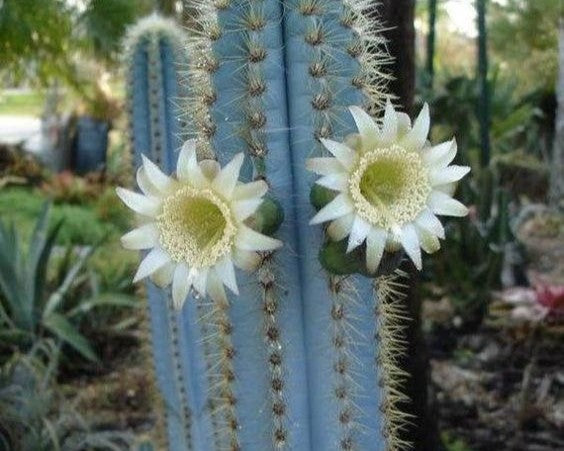
Caring for the Blue Torch Cactus
Caring for the Blue Torch Cactus
The Blue Torch Cactus, scientifically known as Pilosocereus azureus, is a striking and easy-care plant that adds a bold, sculptural vibe to any space. Originating from Brazil's dry, tropical regions, this cactus stands out with its tall, upright growth habit and unique blue hue. Unlike typical green cacti, the Blue Torch Cactus has a distinctive bluish-grey waxy coating on its ribs, contrasting beautifully with the golden spines that line its surface. Reaching heights of up to 10 feet in its natural habitat, this cactus can also bloom, producing vibrant flowers in shades of white and yellow—though indoor blooms are rare.
General Care Guide
Light
As a desert native, the Blue Torch Cactus craves sunlight—lots of it! Ideally, place it in a bright, sunny spot where it can soak up at least 6 hours of direct sunlight daily. If you're growing it indoors, make sure it's near a south-facing window for optimal light exposure. While this cactus thrives in full sun, it can tolerate partial shade, but you may notice its beautiful blue colour fading slightly in lower light conditions.
Water
When it comes to watering, less is more for the Blue Torch Cactus. Like most cacti, it is drought-tolerant and stores water in its thick, ribbed structure. During the growing season (spring and summer), water the cactus deeply but allow the soil to dry out completely between waterings. In winter, reduce watering significantly, as this is its dormant period. Overwatering is the biggest risk with this plant, so avoid soggy soil, which can lead to root rot.
Humidity
This cactus is built for arid environments and prefers low humidity levels. Too much humidity can promote fungal issues and rot. If you live in a humid climate, ensure good air circulation around the plant. Indoors, most homes provide the dry air it loves, so you won’t need to worry about humidity.
Soil
The Blue Torch Cactus needs fast-draining, gritty soil to mimic its natural desert environment. A commercial cactus or succulent mix works well, but you can also create your own by mixing potting soil with coarse sand and perlite. The key is ensuring the soil doesn't retain excess moisture, as this could cause root rot. A pot with good drainage holes is essential, whether you're growing it indoors or out.
Indoors, Outdoors, or Both?
The Blue Torch Cactus is incredibly versatile. It thrives outdoors, where temperatures stay relatively warm year-round. If you live in a cooler climate, you can keep it outside during the summer months and bring it indoors when temperatures drop. Indoors, it's a wonderful choice for sunny windowsills, patios, or sunrooms. Just make sure it gets plenty of light, and it will grow tall and proud.

Common Plant Problems and Solutions
- Overwatering: The most common issue with the Blue Torch Cactus is overwatering, which can lead to root rot. Always make sure the soil dries out completely between waterings. If your cactus starts turning mushy or brown at the base, cut back on watering immediately, and if possible, repot the plant in dry, well-draining soil.
- Pest Issues: Although not very prone to pests, the Blue Torch Cactus can occasionally attract mealybugs or spider mites. If you notice cotton-like clusters or tiny webs on the plant, wipe them off with a cotton swab dipped in rubbing alcohol or spray the plant with a mild insecticidal soap.
- Etiolation: If your cactus starts to stretch or lean toward the light, it's a sign that it isn't getting enough sunlight. Move it to a brighter location and rotate the pot occasionally to ensure even growth.
- Sunburn: While it loves sunlight, sudden exposure to intense, direct light—especially after being kept in lower light—can cause sunburn, leaving the skin with brown or yellow patches. Introduce it to direct sunlight gradually, particularly after a move or winter dormancy.
Fun Facts About the Blue Torch Cactus
- Natural Night Bloomer: In the wild, the Blue Torch Cactus produces stunning white flowers that bloom at night, attracting nocturnal pollinators like bats and moths.
- Edible Fruit: After the cactus blooms, it produces small, edible fruits that resemble tiny, colourful berries—though wildlife rather than humans mostly appreciate them.
- Unique Blue Coating: The bluish colour of the cactus isn't from its actual tissue but from a waxy coating called 'glaucous bloom,' which helps protect it from intense sunlight and water loss in its native desert environment.
